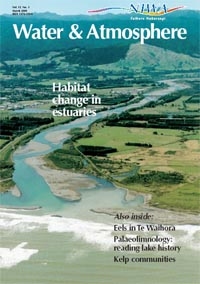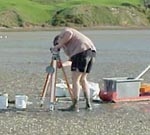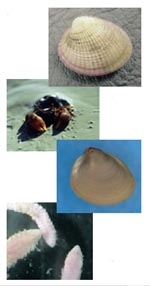PDF of this article (335 KB)

Jane Halliday Simon Thrush Judi Hewitt Greig Funnell
Climate change has been predicted to make our estuaries muddier. How will this affect the species living within the sediment?

Increasing inputs of mud are probably one of the most serious threats to our estuaries. A range of research projects has looked at the effects of excess fine sediment on individual estuarine animals and animal communities. Until recently, however, little information has been available to help managers and ecologists forecast how these animals might respond to long-term changes in sediment type.
We have now developed several statistical models that will allow us to forecast changes in the distribution and abundance of several important intertidal species as sediment mud content changes.
Building a dataset


To look for relationships between estuarine communities and the environment – especially sediment type – we needed information from many estuaries. Since few data exist already, the first step was to design survey methods to gather data rapidly and cost effectively.
Our survey included 19 sites in 18 North Island estuaries, harbours and embayments (see map). At each site we collected samples from areas ranging from deep, soft mud to firm sand, all in the intertidal zone. By limiting the sampling to a small area within each estuary we tried to minimise the effect of other factors such as salinity and elevation on relationships between animals and sediment muddiness. We identified the species present in each sample, and determined their abundance. For each sample we also assessed the content of sand and mud.
Of the 92 invertebrate species identified in the survey, we chose 13 common species for modelling. These species represented different phyla (e.g., worms or snails), different feeding methods (e.g., grazers or predators) and different life histories (short-lived or long-lived species). Some of the species selected for modelling were a mud crab, an anemone, several species of worms and three shellfish.
Two kinds of model
Using the data for the 13 common species we developed two types of simple model. Both are relevant to the naturally patchy distribution of estuarine animals.
The first was an occurrence model. This forecasts the probability of a species occurring at a given mud content (0–100% chance). The second model forecasts the maximum density that a species could achieve in a given mud content. The maximum density of a species is more ecologically meaningful than its occurrence because the way in which animals interact with their ecosystem – predation, resuspending sediments – is often most significant when there are many animals present. Modelling changes to maximum density therefore helps to provide an insight into the threat that increased sediment mud content may pose for both biodiversity and the ecosystem.
The occurrence models explained 60–81% of the variation in species distribution found in the survey. Forecasted occurrences of some species are plotted against sediment mud content. The models show a variety of shapes indicating that each species reacts differently to sediment mud content. For example, the mud crab Helice crassa is more likely to occur in areas with high mud content. In contrast, you are more likely to find cockles at sites with little mud. The polychaete worm Boccardia syrtis is most likely to occur at sites with an intermediate percentage of mud.
To derive the maximum density models, we plotted the chance of a species occurring at maximum density against sediment mud content for each species. From our dataset, most models explained at least 60% of the variability in the distribution of maximum density. An exception was the mud crab Helice, where maximum density did not seem to be related to sediment mud content at all. In this case we think another environmental variable (such as food supply or water chemistry) must have been controlling their abundance.
The maximum density models varied from simple line relationships (mud crab Helice), to curved (polychaete worm Aonides), and humped relationships (polychaete worm Aquilaspio) to bell-shaped response curves (polychaete worm Heteromastus). (For more detail, see the PDF of this article.)
In general, the two models showed similar responses to mud content for individual species. For example, both models indicated that the polychaete Aonides preferred sand, and was unlikely to occur, or be at maximum density, in mud.
Interestingly, for a few species the two models gave quite different responses to mud content. For example, in the maximum density model the polychaete Heteromastus preferred 20–40% mud, whereas in the occurrence model there was no preference. The maximum density models generally predicted a smaller habitat preference range than the occurrence models. This makes sense ecologically because some species may be found at very low densities across a variety of habitats; yet their preferred habitat – where they occur at high density – may only span a short range of mud content.
Habitat preferences
Estuarine species are thought to be very tolerant of a wide range of environmental conditions. If this is true, the relationship between mud content and occurrence or maximum density should be a flat line. However, both models show that most of the 13 species have habitat preferences either for sand, mud or mixed sediment.
An interesting example is for the four spionid polychaete worms, Aonides, Aquilapsio, Boccardia and Scolecolepides. These are closely related, they have similar general natural history characteristics, and all are surface deposit feeders. However, our models for each species are quite different. For example, Aonides appeared to be the most sensitive to increased muddiness, while Aquilaspio appeared to prefer 20–50% mud. This highlights the pitfalls of making predictions from ecological data based on broad taxonomic groups or by feeding method.
Future work
Models such as these can be used to forecast the effects of habitat change on the ecology of estuaries. For example, our data suggest that if climate change and catchment development continue to cause estuaries to get muddier, mud-sensitive species, such as the polychaete Aonides and bivalves, will decrease in abundance.
The next step in developing these models is to test them on data collected from different locations. Eventually it should be possible to combine them with other models, such as risk assessment models (see Water & Atmosphere 10(2): 18–19; 10(4): 22–23), in order to get a long-term assessment of the possible impacts of environmental changes on estuaries and the flow-on effects to sediment-dwelling animals.
Teachers: this article can be used for NCEA Achievement Standards in Biology (2.5, 2.9, 3.1, 3.2), Science (2.2, 2.3), Geography (3.1). See other curriculum connections at www.niwa.co.nz/pubs/wa/resources
Jane Halliday, Simon Thrush, Judi Hewitt and Greig Funnell are all based at NIWA in Hamilton.
Our estuaries are changing
There is good evidence that sediment loading to New Zealand’s estuaries and coasts has increased along with human population growth and the development of coastal margins. This has been highlighted in several recent articles in Water & Atmosphere (for example, see 11(1): 11–15). Most sediment is washed into estuaries during floods. Therefore, estuaries with steep catchments, heavy sporadic rainfall, and land-use development are at high risk of inundation by fine sediment. Climate projections for many parts of the planet, including New Zealand, indicate that sea level will rise, rainfall will be more intense and the frequency of storms will increase. This climate-change scenario points to even muddier estuaries in the future.
Further reading
Thrush, S.F. et al. (2003). Habitat change in estuaries: predicting broad-scale responses of intertidal macrofauna to sediment mud content. Marine Ecology Progress Series 263: 101–112.
Acknowledgement
This research was carried out in the FRST-funded programme “Effects of Sediments on Estuarine and Coastal Ecosystems” (C01X0024).
